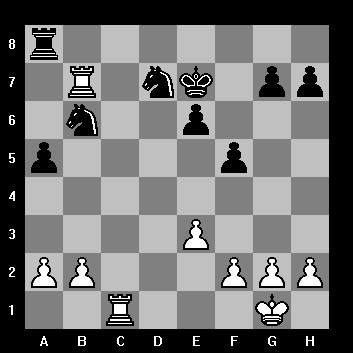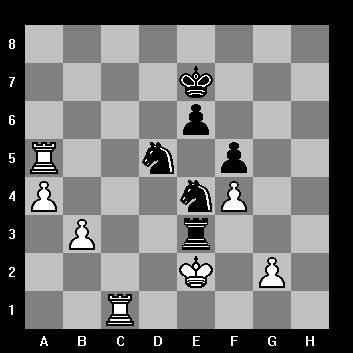05.10.2006
Game VIII V.Kramnik - V.Topalov
1.d4 d5 2.c4 c6 3.Nf3 Nf6 4.Nc3 e6 Having swapped the colours, the adverrsaries continued their theoretical discussion in a Slav defence. 5.e3 Nbd7 6.Bd3 dxc4 7.Bxc4 b5 8.Be2 This retreat with the bishop is regarded as harmless for black. Yet Aleksej Aleksandrov used to stand up for this variation.8.Bd3 is the main reply.8...Bb7 9.0-0 b4 A small surprize, line 9...Be7 10.e4 b4 11.e5 bxc3 12.exf6 Nxf6 13.bxc3 0-0 14.Rb1 Qc7 15.Bf4 Qxf4 16.Rxb7 Bd6 is considered to lead to equality.] 10.Na4 c5 11.dxc5 Nxc5 12.Bb5+ Ncd7 13.Ne5 Qc7 14.Qd4 [in the game Shinkevich,V-Somkin,E/Bor 2000 14.Nxd7 Nxd7 15.e4 Rd8 16.Bg5 f6 17.Be3 took place, and white got an initiative position. Accepting a pawn sacrifice would be a principal way of responding, 15...Bxe4! led to sharp fight. It's clear, that Vladimir Kramnik is reluctant to play such a position, his leading in the match taken into account. 14...Rd8 [14...Bd6 15.Nxd7 Nxd7 16.Rd1 Bxh2+ 17.Kh1 Bc6 18.Bxc6 Qxc6 19.Kxh2 Qxa4 20.Bd2 favours white]

15.Bd2 [A7-pawn is poisoned. After 15.Qxa7 Bd6 black seizes the initiative; 15.Rd1 is met with simple and strong 15...a6!] 15...Qa5 Natural novelty, in a game played long ago Cvetkovic-Bagirov,Vrnjacka Banja 1974 black lost a tempo: 15...a6? 16.Rfc1 Qa5 17.Bc6, etc. 16.Bc6 Be7 Black could have plunged into the abyss of complications immediately - 16...Bxc6 17.Nxc6 Qxa4 18.Nxd8 Be7! (Of course, not 18...Kd8- the king in this cases gets under attack on c and d-files, for example: 19.Rac1 a5 20.Rc4!) 19.Nb7 Qa6 20.Bxb4 Qxb7 21.Bxe7 Kxe7 and the resulting position is double-edged.] 17.Rfc1 Bxc6 [White's idea was concluded in the variation 17...0-0 18.Nc4 Qc7 19.Bxb7 Nc5 20.Qe5 Qxe5 21.Nxe5 Nxb7 22.Be1 , and black faces unpleasant prospects of fighting for draw.]17.Rfc1 Bxc6 18.Nxc6 Qxa4
It's interesting now but extremel;y risky to play 19.Nxe7!? Kxe7 20.Bxb4+ Ke8 21.b3 Qa6 - there's no direct checkmate, and black' extra piece may eventually tell. Intermediate 19.b3!? deserved attention, choosing an attck continuation depending on where black queen retreats (b5 or a6). A sample continuation: 19.b3 Qb5 (19...Qa6 20.Bb4) 20.Qa7!? Qb6! (20...Bc5 21. Qc7 Ra8 22.Rc5! Qc5 23.Bb4 with a compensation for a rook(!); 20...Rc8 21.Nd4 with attack) 21.Qa4 Rc8 appears to be not dangerous for black.] 19...Bxd8 20.Qxb4 Vladimir chooses the most direct and simple way, but the resulting endgame is of double-edged nature, and black's chances are clearly not worse. 20...Qxb4 21.Bxb4 Nd5 22.Bd6 f5 23.Rc8 The rook cannot hold out on the 8th rank -23...N5b6 24.Rc6 Kf7, preparing bishop's comeout to f6

23...N5b6 24.Rc6 Be7 Topalov takes a decision to exchange the dark-squared bishops - he wants a central square e7 to be occupied with his king. 25.Rd1 Yet black king will have to confine itself with f7-square. 25...Kf7 26.Rc7 If black exchanges white active rook by 26...Rc8, then after the exchanges 26.Rxc8 Nxc8 27.Bxe7 Kxe7 white rook will be not weaker than black remaining two knights. To fight for win black need to keep his rook on the board.
26...Ra8 27.Rb7 The evaluation of the position is as follows: if black manages to chase the rook off the 7th rank, he will have advantage. Necessity to exchage it on the black one would lead to equalization. 27...Ke8 28.Bxe7 Kxe7 29.Rc1 a5! A strong move preventing b2-b4-b5 clamp and meanwhile giving a8-rook some freedom.

30.Rc6 Nd5 31.h4! Also very good - white has no direct play, thus he prevents possible capturing space on the kingside that otherwise could be started with 31...g7-g5! 31...h6 Black prepares g7-g5 anyway. Another deserving attention idea is 31..a4 with the same grounds as 29...a5. 32.a4 A very obliging decision. Another obliging decision 32.h5 still looks better. Of course h-pawn gets isolated from its mates, but it's difficult to use this circumstance insofar as black knights are pinned.32...g5 33.hxg5 hxg5
It may be stated that black's advantage has certainly gone beyond the range of a purely symbolic one.
34.Kf1 g4 35.Ke2 N5f6 35.b3 It may have been worth tring to strengthen the pin by 36.Rcc7 Kd6 (36...Rh8 37.Ra7 Rh2 38.g3 is not so dangerous) 37.Ra7 Rb8 38.Rcb7 Rxb7 39.Rxb7 Nc5 40.Rb5 Nxa4 41.Rxa5 Nxb2 White must hold the resulting ending.] 36...Ne8! Black is trying to drive the rook out of b7
37.f3 Now is likely to follow 37...Nd6, and after 38.Rbc7 black has a pleasant choice: 38...gxf3+ 39.gxf3 e5 followed by Ke6, or 38...g3!?
37...g3 Topalov decides to put off move Nd6. 38.Rc1 Nef6 38...Nd6 appeared more natural, but Topalov's decision is also quite interesting, the knights defends each other. 39.f4

39...Kd6 40.Kf3 Nd5
Black's advantage has grown even more, it's extremely difficult for white to save the game.
41.Kxg3 41.Ra5 may be replied with 41... Ra7 threatening Nc7 and white will not save the game.
41...Nc5 The strongest. Topalov seems to achieve his first victory.42.Rg7 Rb8 Taking any of two pawns would be no less efficient way to win. 43.Ra7 Rg8 44.Kf3 Ne4 45.Ra6 Ke7 46.Ra5 Rg3 47.Ke2 Re3

48.Kf1 Rxb3 49.Ra7 Kf6 50.Ra8 Nxf4 51.Ra1 Rb2 52.a5 Rf2
White resigned.
-------------------------------------------------
Summary.
In game 8 Vladimir Kramnik chose a calm variation that often turns out to be an omen of draw, but Topalov surpized Volodya with a rare branch that is considered to be dangerous for black. In the resulting position both opponents acted irreproachably, but at one moment Vladimir was failed by his desire to play safer - instead of continuing his attack (it must be said, it was risky yet followed from the requirements of the position) he preferred seemingly harmless yet potentially dangerous endgame. It turned out far from easy to defend the endgame, it's even difficult to point out a moment at which black's advantage became decisive. This way or another, Topalov's technique proved to be up to the mark, and the score of the match got levelled.
